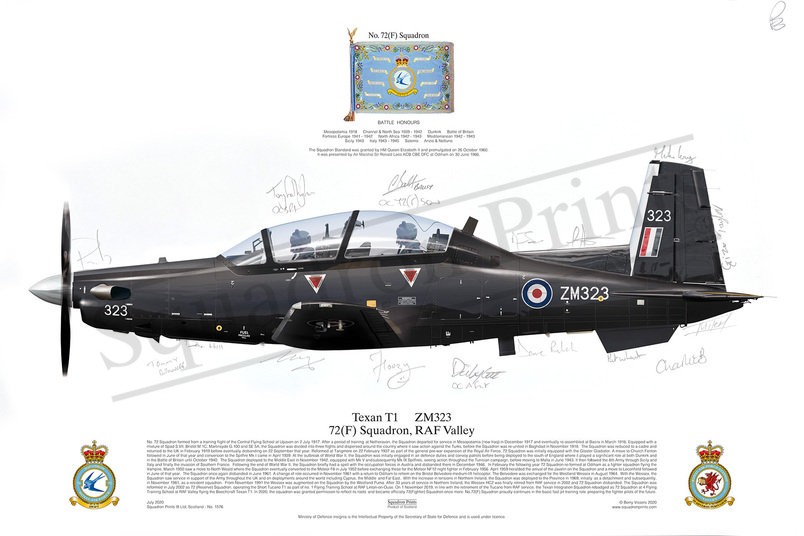#1576SIG Texan T1 Signed Print

Description
Squadron Prints Lithograph No. 1576 - ZM323, Texan T1, 72(F) Squadron, RAF Valley. Signed in pencil by Boss and Squadron Members.
No. 72 Squadron formed from a training flight of the Central Flying School at Upavon on 2 July 1917. After a period of training at Netheravon, the Squadron departed for service in Mesopotamia (now Iraq) in December 1917 and eventually re-assembled at Basra in March 1918. Equipped with a mixture of Spad S.VII, Bristol M.1C, Martinsyde G.100 and SE 5A, the Squadron was divided into three flights and dispersed around the country where it saw action against the Turks, before the Squadron was re-united in Baghdad in November 1918. The Squadron was reduced to a cadre and returned to the UK in February 1919 before eventually disbanding on 22 September that year. Reformed at Tangmere on 22 February 1937 as part of the general pre-war expansion of the Royal Air Force, 72 Squadron was initially equipped with the Gloster Gladiator. A move to Church Fenton followed in June of that year and conversion to the Spitfire Mk I came in April 1939. At the outbreak of World War II, the Squadron was initially engaged in air defence duties and convoy patrols before being deployed to the south of England where it played a significant role at both Dunkirk and in the Battle of Britain until October 1940. The Squadron deployed to the Middle East in November 1942, equipped with Mk V and subsequently Mk IX Spitfires, seeing action throughout the Tunisian campaign, before moving to Malta in June 1943. It then followed the 8th Army through Sicily and Italy and finally the invasion of Southern France. Following the end of World War II, the Squadron briefly had a spell with the occupation forces in Austria and disbanded there in December 1946. In February the following year 72 Squadron re-formed at Odiham as a fighter squadron flying the Vampire. March 1950 saw a move to North Weald where the Squadron eventually converted to the Meteor F8 in July 1952 before exchanging these for the Meteor NF12 night fighter in February 1956. April 1959 heralded the arrival of the Javelin on the Squadron and a move to Leconfield followed in June of that year. The Squadron once again disbanded in June 1961. A change of role occurred in November 1961 with a return to Odiham to reform on the Bristol Belvedere medium-lift helicopter. The Belvedere was exchanged for the Westland Wessex in August 1964. With the Wessex, the Squadron saw service in support of the Army throughout the UK and on deployments around the world including Cyprus, the Middle and Far East. With the increase in tensions in Northern Ireland, the Squadron was deployed to the Province in 1969, initially as a detachment and subsequently, in November 1981, as a resident squadron. From November 1991 the Wessex was augmented on the Squadron by the Westland Puma. After 33 years of service in Northern Ireland, the Wessex HC2 was finally retired from RAF service in 2002 and 72 Squadron disbanded. The Squadron was reformed in July 2002 as 72 (Reserve) Squadron, operating the Short Tucano T1 as part of no. 1 Flying Training School at RAF Linton-on-Ouse. On 1 November 2019, in line with the retirement of the Tucano from RAF service, the Texan Integration Squadron rebadged as 72 Squadron at 4 Flying Training School at RAF Valley flying the Beechcraft Texan T1. In 2020, the squadron was granted permission to reflect its roots and became officially 72(Fighter) Squadron once more. No.72(F) Squadron proudly continues in the basic fast jet training role preparing the fighter pilots of the future.
You may also like
-
Tornado GR4
ZG75016 Sqn; 12 Sqn; 15 Sqn; 617 Sqn; 13 Sqn; 31 Sqn; 20 Sqn; 2 Sqn; 17 Sqn; 27 Sqn; 9 SqnRAF Lossiemouth; RAF Marham
